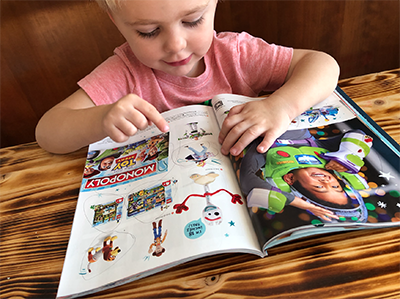 It’s here.
It’s here.
My Amazon Toy Catalog, pleasantly thick with a high-quality matte cover, just hit my mailbox a few days ago. The first thing I noticed flipping through is the sticker page inserted inside, making it easy (and totally fun) to tag your faves as you browse. Fun, and engaging.
Then next thing I noticed is the holiday wish list on heavy stock, right inside the front cover, and a message to curl up with the cocoa and “check this book twice.” Nice touch.
They get it. They get the physical appeal of print, and the emotional appeal of a good catalog, put together to tell a story about the kind of holiday you can create.
Then I noticed something else … no prices, for both tactical and strategic reasons.
“The catalog is the second edition that Amazon produced, and while there are some similarities with the 2018 edition, this year Amazon has rolled out a few new tricks to ensure they capture their slice of the holiday shopping pie,” writes Kiri Masters in Forbes.
“The products have no prices, just ‘Scan & Shop’ QR codes linking back to the online page,” Masters continues. “Since Amazon reprices items on its site millions of times per day, it’s impossible to advertise a set price for each item. This nifty workaround not only ensures customers don’t see a price that Amazon can’t hold, but it draws shoppers back to the site immediately.”
Based on their fluid pricing model, I see why this is necessary. Even without that catch, a good catalog inherently drives customers to the site to order, one of the true values of modern catalogs.
According to Masters, it appears that Amazon is personalizing its catalogs using customer data. It makes sense; they practically invented the use of customer data to target their audience.
“The recipient of the catalog shown in these pictures has a two year old child, and we noted that most items in the catalog at the start and mid-point of the catalog were geared toward a toddler-level audience,” she notes. “Another catalog recipient, this time with older children, found the order of the assortment offered to be different, with older kid toys at the start and younger kid toys at the end.”
There’s a lot to love about Amazon’s toy catalog, not the least of which is the fact that the biggest online retailer recognizes the value of printing and mailing catalogs. We can stop asking if digital brands need catalogs. It’s clearly worth it to them.
It’s beginning to look a lot like holiday time, and we couldn’t be happier.

December 10, 2020, 2:17 pm